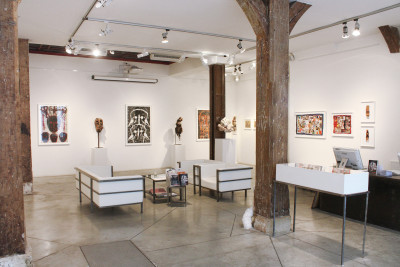michel nedjar
momentum (a retrospective)
Michel Nedjar’s extraordinary trajectory raises a question that is rarely addressed: the possible impermanence of Art Brut.
Jean Dubuffet wrote to him of his admiration on numerous occasions, and the addition of his work to his Art Brut collection was accompanied by a text by the great English critic, Roger Cardinal, while many dozens of his pieces appear today in the Centre Pompidou’s collections. Discovered almost 35 years ago, today he is without a doubt the living Brut artist who has been the most exposed worldwide, and who has been the subject of a great number of publications.
When Michel Nedjar – born in 1947 and haunted since his youth by the decimation of his family in Nazi camps – produced his first dolls (his “soul flesh” series, a pun on the French for “dear ladies”), which he covered in dirt and blood, with rags gathered in the Goutte d’Or neighborhood, the creative impulse of this man who was destined to become a tailor, like his father, looked at the time more like a release or a conjuration. But after that point, his life would change direction, to the extent that the enthusiasm of elites for his creations, arisen from pure necessity, would reveal to him his true calling to be an artist.
Thus, it is difficult to understand how Michel Nedjar was later able to continue to be considered a Brut artist. But it is probable that the explanation depends on the very form of his works, and on the poor materials that he continued to use to create them.
We can even legitimately ask ourselves if this misunderstanding wasn’t consciously upheld by the sycophants of Art Brut who, through their dogmatism, were more concerned with imposing an iconography meant to widen an artificial frontier with the art of our time.
Though it would be better to hail, as did Dubuffet, the “flamboyant sorcery” and the “high mental incandescence” that Michel Nedjar’s art allows us to attain.
This retrospective – which retraces all of the periods of Michel Nedjar’s creation (dolls – old and new –, papier mâchés, terra cottas, coudrages (sewn collages), paintings and drawings) – is meant to vibrantly bear witness to this momentum.
He is the most widely exhibited and published living art brut artist, yet the extraordinary trajectory of this Frenchman raises a question that is rarely addressed: that of the impermanence of art brut. Discovered by Jean Dubuffet at a time when he was working on the resurgence of the symbolic body, he allowed himself to become the protean artist we know and who, in his creation, embodies absolute freedom. His work can be found in countless collections, and he was the first artist brut to enter the collections of the Musée national d’art moderne (Pompidou). Exhibited at the Monnaie de Paris, the Albertina Museum and the Mona, Michel Nedjar has been the subject of nine monographic exhibitions.

Preface : Stéphane Corréard
Foreword : Christian Berst
Catalog published to mark the exhibition Michel Nedjar : momentum (ua retrospective), from may 23rd to july 12th, 2014.





